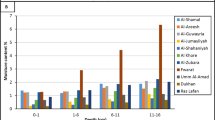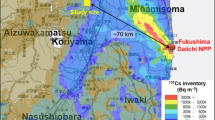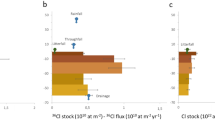Abstract
The fallout of radiocaesium after the Chernobyl accident has renewed interest in its environmental behaviour. How it behaves in soils and sediments is important, for example, for the modelling of radiocaesium transport and retention in soils, and transfer from soil to plants and hence into the food chain. The traditional approach is highly empirical and is based on the measurement of solid–liquid distribution coefficients (KD values) and transfer factors. It is generally believed that radiocaesium retention in soils and sediments is due to the presence of a small number of highly selective sites. Neither their abundance nor their Cs-selectivity has been quantitatively determined. Here we report a new methodology which achieves such characterization. Previously studies of radio-caesium in soils have foundered because KD values have been derived under conditions very different from those in situ. We show that in situ KD values can be predicted from readily measurable soil properties, thus enabling information about the mobility of radiocaesium in soils to be reliably and easily obtained. These findings can be generally applied to a wide variety of soils.
This is a preview of subscription content, access via your institution
Access options
Subscribe to this journal
Receive 51 print issues and online access
$199.00 per year
only $3.90 per issue
Buy this article
- Purchase on Springer Link
- Instant access to full article PDF
Prices may be subject to local taxes which are calculated during checkout
Similar content being viewed by others
References
Sawhney, B. L. Clays Clay Miner. 20, 93–100 (1972).
Francis, C. W. & Brinkley, F. S. Nature 260, 511–513 (1976).
Evans, D. W., Alberts, J. J. & Clark, R. A. Geochim. cosmochim. Acta. 47, 1041–1049 (1983).
Bolt, G. H., Sumrner, M. E. & Kamphorst, A. Soil Sci. Soc. Am. Proc. 27, 294–299 (1963).
Ritchie, J. C. Literature relevant to the use of radioactive fallout Cesium-137 to measure soil erosion and sediment deposition Tech. Rep. HL-9 (U.S.D.A. Beltsville, 1987).
Brouwer, E., Baeyens, B., Maes, A. & Cremers, A. J. phys. Chem. 87, 1213–1219 (1982).
Cremers, A. & Pleysier, J. Nature 243, 86–87 (1973).
Pleysier, J. & Cremers, A. J. chem. Soc. Faraday Trans. I 71, 256–264 (1973).
Chhabra, R., Pleysier, J. & Cremers, A. in Proc. Int. Clay Conf. (ed. Bailey, S. W.) 439–449 (Appl. Publs Lim., 1975).
Harmsen, K. in Soil Chemistry—B. Physico-chemical models (ed. Bolt, G. H.) Chapter 4 (Elsevier, 1979).
Barrer, R.M. & Klinowski, J. J. chem. Soc. Faraday Trans. I 68, 1956–1963 (1972), 75, 247–251 (1979).
Mubarak, A. & Olsen, R. A. Soil Sci. Soc. Am. J. 40, 329–331 (1976).
Author information
Authors and Affiliations
Rights and permissions
About this article
Cite this article
Cremers, A., Elsen, A., Preter, P. et al. Quantitative analysis of radiocaesium retention in soils. Nature 335, 247–249 (1988). https://doi.org/10.1038/335247a0
Received:
Accepted:
Issue Date:
DOI: https://doi.org/10.1038/335247a0
This article is cited by
-
Irrversible cesium adsorption capacity of granite-origin soil
Journal of Radioanalytical and Nuclear Chemistry (2024)
-
Radiocesium mobility in different parts of the two major tree species in Fukushima
Scientific Reports (2023)
-
Sorption behavior studies of Cs and its migration in soil samples around Visakhapatnam, India
Environmental Monitoring and Assessment (2023)
-
Adsorption forms of cesium in specific soils based on EXAFS spectroscopic investigations and sequential extraction experiments
Journal of Radioanalytical and Nuclear Chemistry (2023)
-
Vegetation stability during the last two centuries on the western Tibetan Plateau: a palynological evidence
Frontiers of Earth Science (2023)
Comments
By submitting a comment you agree to abide by our Terms and Community Guidelines. If you find something abusive or that does not comply with our terms or guidelines please flag it as inappropriate.



